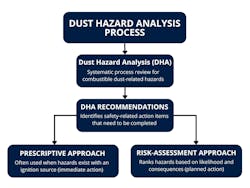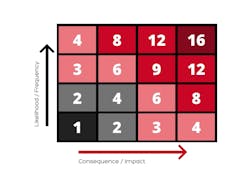Completed a Dust Hazard Analysis at your plant? Here's what to do next
In 2021, there were 129 combustible dust incidents in the United States and Canada. This included 109 combustible dust fires and 20 combustible dust explosions. Sadly, even as safety is evolving and detection and prevention technologies improve, combustible dust incidents still occur. Because combustible dusts are part of many manufacturers’ operations, completing a now-required Dust Hazard Analysis (DHA) is important to keep your plant in compliance with combustible dust regulations and protect against such incidents, which can result in downtime, equipment and plant damage, citations and, worst of all, danger to workers.
To help ensure that all manufacturers handling combustible dust are aware of their plant’s unique process hazards, the National Fire Protection Association (NFPA) developed the Standard on the Fundamentals of Combustible Dust (NFPA 652). The standard contains retroactive requirements (enforced by OSHA) to help companies better understand and manage the hazards of combustible dust. It is important to note that the general DHA deadline set by regulators was January 1, 2022, so all companies must now meet this requirement. According to NFPA 652 language, “The DHA shall be reviewed and updated at least every 5 years.”
In fact, the first step outlined in NFPA 652 and in each commodity-specific NFPA standard addressing combustible dust safety is that each facility must conduct a DHA. A DHA is simply a systematic way to review the processes and areas in a facility where combustible dusts and particulate solids are present. These processes and areas are assessed to identify where hazards exist, what safeguards are currently in place, and what further safeguards may be needed to maintain combustible dust safety.
Typically, a DHA can be performed in-house if a company has a safety management team with the needed expertise or by an outside expert that specializes in DHAs such as a consultant. It’s important to have a reputable consultant perform this analysis because of the liabilities associated with dust fires and dust explosions. Once completed, you’ll want to use your DHA results to ensure that either your process or facility has a sound process safety plan in place or that you can implement any necessary changes to your plant or facility’s current process to adhere to industry standards and regulations.
What does a DHA typically include?
Various factors can influence the DHA process and the resulting DHA action items generated. These factors and their related actions can be divided into four general categories:
1. Administrative responsibilities
a. Training programs should be in place for any plant personnel dealing with combustible dust. The level of training required depends on the potential exposure to combustible dust. Even outside contractors coming into the plant may require training.
b. Emergency response plans should be in place and reviewed annually to ensure that personnel are aware of how to respond to a combustible dust incident.
c. Management-of-change protocols should be established and followed. Having a procedure in place can promptly address any dangers that could potentially be introduced when a process change occurs between DHA reviews.
2. Documentation
a. Recording information should be standard practice, with a way to manage and retain information on process changes, current safety plans, notes of any safety incidents, and the principles guiding the design of any process safeguards.
b. Relevant codes and standards should be readily available to personnel in relation to your processes. If you process a metal dust, for example, operators should refer not only to NFPA 652, but also NFPA 484, which focuses on combustible metal powders and dusts.
3. Existing safeguards
a. Initial design of any process line may include safeguards against dust deflagration and explosion with relevant dust explosion prevention or mitigation integrated into design specifications. A facility should consider safety at the planning stage of a new line or when new equipment is installed. Typically, some equipment can have the option for built-in safety features to combat combustible dust hazards such as heat sensors or even a flameless explosion vent. However, inclusion of the proper safety features at the outset can depend on the equipment manufacturer and the project budget.
b. Maintenance can be an important safeguard against a dust fire or explosion. Proper equipment maintenance can ensure that any wear parts are replaced before they compromise safety, such as a worn bearing potentially creating an ignition spark. Procedures for safely maintaining equipment often include safety interlocks to prevent inadvertent energy releases, which could cause ignition.
c. Housekeeping safeguards your plant from a combustible dust incident because if there isn’t enough combustible dust for fuel, a fire or explosion cannot occur. Regularly perform housekeeping tasks such as using a central vacuum system to clean up any fugitive combustible dust. (Note that an improperly sized or maintained central vacuum system can be a potential source of a dust deflagration as well!)
d. Safety equipment reliability can also be an important safeguard for operators. When safety equipment is reliable, it is more predictable and simpler to maintain. This also makes it easier for personnel to notice if there’s a problematic deviation from normal operations and proactively monitor combustible dust issues instead of simply reacting to them.
e. Process interlocks help to prevent unsafe equipment operation and are critical to providing proper signaling of events in modern, interconnected plants. Interlocks help with sequencing to control when other process equipment shuts down during a fire or explosion.
4. Required safeguards
a. Prevention systems can provide an integral part of a plant’s safety management plan and may be used when fire and explosion risks in a plant area are high. Prevention can include spark detectors and gas detectors paired with a suppression system that uses water to smother a fire or spark almost instantaneously before it can spread in a process area.
b. Mitigation systems are considered by most regulators as the minimum solution for addressing a combustible dust hazard. These solutions focus more on fire and pressure management during a combustible dust event to limit damage. These solutions can include explosion vents, flameless vents, suppression systems, and isolation valves, which may work in concert with sensors and controllers to monitor device or system functionality and, in some cases, allow for testing and resetting.
c. Design documentation is required for any combustible dust safety plan. This may include both explosion prevention and mitigation as well as any other DHA-related information as outlined in NFPA 652. If an OSHA inspector or other authority having jurisdiction were to ask for a DHA, you must produce it or be subject to a fine.
Responding to DHA recommendations
Companies typically respond to DHA recommendations using either a prescriptive approach or a risk-assessment approach to address any required actions, as shown in Figure 1. If your DHA identifies that dust exists along with an ignition source, you may need to immediately perform a prescriptive approach to address that issue. If the DHA finds varying hazards, then a risk-assessment approach can help you strategically utilize company resources to address all the hazards identified. The critical factor is to have a plan to address action items that includes a timeframe for completion that satisfies your internal safety concerns as well as those of external regulatory bodies, which may have input on timelines to address certain hazards identified during the DHA process or a plant inspection.
While all plants must seek to address any required DHA actions, they may find it necessary to consult with a trusted safety consultant or reputable company with experience. Some companies may simply not have the safety management personnel in place to address the intricacies of a DHA’s findings, but the consequences of noncompliance can include regulatory penalties, equipment rebuild and repair costs, insurance premium increases, and injuries and fatalities. The following is a more detailed description of the prescriptive and risk-assessment approaches to addressing required actions from a DHA.
Prescriptive approach.
The prescriptive approach relies on the DHA report to guide what a facility must do in terms of compliance. The DHA report will describe any issues and directly note what part of the NFPA standard is relevant for solving the issue. Some companies with the resources and staff expertise may choose to implement process changes based solely on the DHA report. In cases where one or more process changes are required in response to the DHA, companies can once again rely on either internal or external resources to respond to the report to prevent an unplanned process shutdown or incident. When a facility has multiple complex process issues across one or more facilities, the prescriptive approach is one option, but plant operators or safety teams may choose to supplement that approach with a hazard evaluation and risk level assignment for each issue raised in the DHA.
Risk-assessment approach.
The risk-assessment approach can be utilized in more complex cases. An initial DHA may recommend hazard awareness training, electrical classification assessment, safety equipment requirements, or even a new housekeeping schedule for a particular plant area. In the face of varied requirements, plant operators and engineers may need to prioritize action items and seek external resources to effectively respond to all required changes. The most common approach is a phased plan that incorporates information from a risk hierarchy that identifies low- and high-risk issues because taking the time to assess risk levels can be advantageous to your company when resources are limited. Creating a risk hierarchy consists of categorizing the hazards by consequence versus the frequency of a potential hazard. Figure 2 shows how a phased plan taking a hazard’s higher-consequence and higher-likelihood into account can identify priority hazards in your plant. Once you have identified priority hazards, you can develop a systematic or phased plan to address them.
During this risk evaluation, the properties of your combustible dust may aid the decision-making process. Specifically, the ignition potential parameter as measured by the minimum ignition energy (MIE) may need to be tested to determine the risk hierarchy. Risk evaluation could include:
- the static discharge risks for powder being handled in an FIBC;
- the ignition temperature for powders that are dried in a rotary dryer (both in a dispersed cloud and as a dust layer); or
- the amount of dust present to be considered a credible hazard.
The benefit to using risk to help prioritize DHA action items is that you can identify your process’ greatest risk exposure from combustible dust hazards. Based on these findings, resources such as capital and personnel time can be best utilized to reduce risk systematically. For example, when considering combustible dust risks, it is important to remember that a combustible dust explosion is eight times more likely to result in a fatality than a combustible dust fire. Therefore, prioritizing explosion risks wherever possible is paramount.
Seek help when needed
It is important to remember that completing a DHA is now a requirement for any facility processing combustible dust, so if your company is struggling to complete or interpret a DHA, seek out trusted industry experts to help you avoid facing regulatory action or possibly a combustible dust-related safety event. For immediate and less-complex DHA findings, a prescriptive approach may suffice, but with more complex DHA results, you can often benefit from taking a phased approach to address hazards identified based on risk and other considerations, including funding, process downtime, and available safety personnel. Keep in mind that a DHA action plan frequently requires an engineered solution utilizing both prevention and mitigation solutions to help you operate your process safely while maintaining regulatory compliance.
Jason Krbec is sales engineering manager at CV Technology and is a licensed professional engineer in the state of Florida. He holds a B.S. in mechanical engineering from the University of Florida and is an active NFPA technical committee member.
CV Technology





